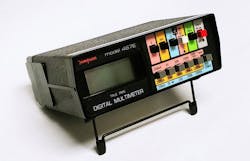What’s the Difference Between Analog and Digital Multimeters?
What you’ll learn:
- Key differences in analog vs. digital features.
- Applications where each type of multimeter is best suited.
Multimeters, from small handheld to more sophisticated benchtop models, are indispensable tools for testing electrical voltage, current, and resistance, and depending on the model, frequency and signal power. Some believe analog meters are inferior to digital, but that’s not the case in many real-world applications. So, dismissing analog out of hand would be a mistake.
Both types of meters have their pros and cons, but the feature gap is narrowing. The ubiquity of integrated circuits in all things electronic has led to a flood of lower-cost digital models. However, there are still times when a digital, analog, or hybrid analog/digital meter can be the right choice for the job(s).
Digital vs. Analog: The Feature Gap Narrows
Inside, analog and digital multimeters use ammeters to measure a circuit’s electric current in amperes. Analog units (Fig. 1), for instance, commonly rely on an electro-dynamometer to measure both ac and dc. Digital units (Fig. 2) utilize components such as resistors and diodes to convert signals to a value that an analog-to-digital converter (ADC) can use to show the measured signal value.
Feature-wise, digital meters generally offer greater speed. Digital meters also eliminate interpolation errors; have no moving parts to break; and provide “auto-ranging” to prevent errors and damage to the meter if the user selects the wrong range (this feature can be done on analog units but is more complicated). They also can test continuity; capacitors, diodes, and transistors; and frequency, as well as record and export data for various test and measurement functions.
Digital meters also have a few drawbacks, starting with their need for an external power source for all measurements. Typically, that means batteries, which cause LCD displays to dim as they lose charge. Moreover, they can record errors due to fluctuations, transients, and even extended use if the unit gets too warm.
While analog meters may not offer apples-to-apples parity in terms of accuracy for small, portable units, advanced desk/benchtop analog units can provide accuracy on a par with digital meters. Analog meters require no power source for current and voltage measurement (but do for measuring resistance). Analog meters also are less susceptible to electric noise; have a broader voltage range; and are suited to adjusting tuning circuits or peaking tunable responses—which isn’t the case with digital meters.
Practical Analog: Ideal in the Field
Hybrids aside, there are practical uses for traditional analog meters, especially in the field as opposed to laboratory uses. Applications range from commercial to industrial uses, particularly in the field in isolated conditions. Examples include monitoring minute value changes in automotive, as well as maintenance of geographically isolated assets in applications ranging from submersible well pumps to agriculture to marine/ship industry applications.
In the field, such electrical investigations often involve hands-on observations in real-time. In these cases, “old-school” analog technology can be the most practical and productive option. For example, because analog units don’t require power for many uses, a technician in the field can be more productive with analog by simply monitoring current through a wire, instead of having to “break open” the component being measured as with a digital meter.
Other applications that may “move the needle” toward an analog meter include rate-of-change observations. For example, if a measurement cycles from 0 to 9 amps, it’s easier to read a needle than the blur of rapidly changing values on a digital display.
In a related use, some analog units provide a zero-center function that places the needle in the middle of the scale. It’s easily viewed as it moves left or right, as opposed to having to view separate, simultaneous positive and negative values that are displayed in separate digital readouts.
Hybrids for “Best of Both” Benefits
Analog and digital features are complementary, and in certain cases work well together—even in the same unit with hybrid analog-digital meters. Since the early 1980s, meters have been offered with both analog and digital features. Today’s hybrid analog/digital models further narrow the feature gap with traditionally digital features such as auto-ranging, data export, and other features that may offer a best-of-both worlds solution.
The real choice depends on the application. Prices, like functions, can vary from lower cost to laboratory models that go for thousands of dollars. Somewhere in the middle are meters for field use.
From inexpensive handhelds to thousands of dollars for calibrated, certified test-and-measurement laboratory models, choices abound for all uses.
About the Author
Milt Novak
Senior Engineer, Simpson Electric Company Inc.
Milt Novak is Senior Engineer at Simpson Electric Company, Inc. Over his 47+-year career at Simpson Electric, Milt has been hands-on in a wide range of company disciples ranging from engineering and product development to quality control and management.


